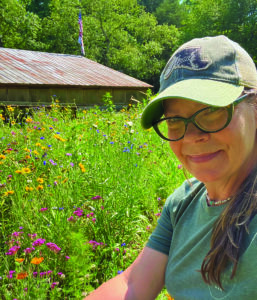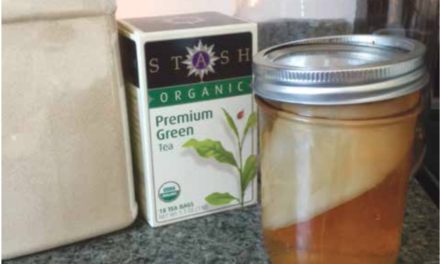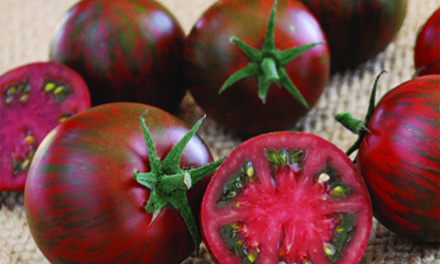
Shayne Darling-Meyer is creating, on Mason Dixon Outfarm in Bridgeville, “a magic space” where visitors “can escape the world for a few minutes and enjoy what they are surrounded by, not what’s in their hand.” (Photos courtesy Mason Dixon Outfarm)
Shayne Darling-Meyer has always been free-spirited and wild, so it’s not surprising that she is passionate about wildflowers and native plants. She is also described as “creative, compassionate and kind-hearted” — so much so that she can’t stand to see a flower trampled, which is why she limits visitors to her meadows and flower gardens to small, intimate gatherings..
Twenty years ago, after begging the owner for years to sell her his 41-acre farm so she could raise her children across the street from her sister, she and her husband, Greg Meyer, purchased a homestead near Bridgeville, Del., which sprawls across the state line into Maryland.
A former tenant told the couple there was a Mason-Dixon line marker on the property. Placed there in 1764 as surveyors Charles Mason and Jeremiah Dixon marked the line every mile with stone shipped from England, the stone has an “M” on the Maryland side and a “P” for William Penn’s Pennsylvania-Delaware side.
A history buff, Shayne learned the property had been sold in the 1800s to one of the tenants. It was listed as an “out farm,” defined as “a farm at some distance from the home farm.” Since part of the land is away from their home, along a country dirt road, they named the property “Mason Dixon Outfarm.”
Most of the farm, 37 acres, is a tree farm planted in loblolly pine which has been in forest stewardship as long as the Meyers have lived there. Decades ago, it was a peach and apple orchard. Before that, hay and potatoes were grown.
The property on one side has been given to the wild for years. Closer to the house, Shayne has been doing basic gardening in a half-acre meadow for the last seven years. Planted in a wildflower mix, it began with her desire to provide food and shelter for birds, bees and butterflies. She enjoyed cutting flowers and giving them away to family, friends and neighbors to brighten their day, and now occasionally offers them, often in repurposed glass, earthenware or teacups, on Facebook or from her “Pop Up Flower Truck,” a Hyundai Santa Cruz.
Her husband has a meadow also, but his purpose in planting it was to lessen mowing chores. He has since doubled the size of his meadow.
They had planned to open the farm, by reservation only, to share for private tours, photographers and artists. Shayne also considered holding seasonal workshops for guests to come plant, pick and make arrangements from the flowers, all at a reasonable cost. “The classes out there cost way too much,” she said. “I want to involve the community at an affordable price.”
A stream runs through the property and the natural setting provides living backdrops for beautiful pictures. She will still allow photographers, but will have stricter limits on when and where they may go. “I’d rather turn business away than eliminate flowers in my fields,” she said. “I didn’t realize how much it bothered me to see flowers stepped on. I don’t want to lose what I’ve worked for, created for the birds, bees and butterflies and homes for other critters.”
She envisions creating “a magic space” where visitors “can escape the world for a few minutes and enjoy what they are surrounded by, not what’s in their hand,” she said. “There will be scenes I create. I hope to inspire others.”
Shayne enlisted the help of Beth Wasden of the Nanticoke Watershed Alliance to convert both existing meadows to native plants, and rye has been added for the birds. They’ll plant another acre this fall. Plans for the expansion include a mix of 75% natives, 25% non-natives. She wants daffodils and sunflowers for bouquets, fruit and nut trees and shrubs for harvesting woody stems. “I want two of everything, all kinds of berries, pawpaw, grapes…,” she said.
“Natives don’t need as much maintenance,” Shayne observed. “I learned the trendy stuff —delicate dahlias and such — just isn’t for me. I love to go out and forage in the wild and in the forest. We have a hedge row that has been there for 50 years. The smell is incredible. I add these foraged treasures to my bouquets.”
She loves the native sunflowers, black-eyed Susans and lanceleaf coreopsis, and non-native batchelor’s button and sweet William, even the non-native and potentially invasive oxeye daisy. Sometimes she will take cut flowers such as these for pop-up sales of DIY bouquets, along with some “grab and go” ready-made arrangements. “I learned a lot of people are nervous making own bundles, so I help. I provide recycled plastic bottles to take the arrangements home.” She has been invited to farmers’ markets, but so far has declined.
With the help of Soil Conservation Service and EQIP (Environmental Quality Incentives Program), a high tunnel has been erected to safely house things like the sunflower and other flowers from the wildlife, deer and bunnies. Fencing surrounds the entire high tunnel to prevent entry. An unused dog kennel has been planted in heritage Hopi Black Dye sunflowers. Sunflowers were planted outside the kennel also, but some of those got eaten recently. “We’re allowing this,” she said. “We live with the animals. They’re here.” She continued, “We have provided a home for the wildlife for 20 years. We just are learning how to have a good balance of the beauty of both the wildlife and the flowers.”
Both Shayne and Greg grew up in large families and learned to use what they have.
She enjoys finding a new purpose for an item, such as an old bottle. “My desire is to get the most out of a flower. I plan to offer fresh, dried and dyed. I can’t wait to dye fabric with my leftover flowers!” she exclaimed.
“My friends say I would be good at this. I wish I had started doing something like this along time ago, but I still have time. I’m in my 50s. I love history, and I’ve discovered the most treasured antique is beneath my feet — my soil.” When she had the soil tested, she was told it was “the best in Delaware, and didn’t need anything.”





